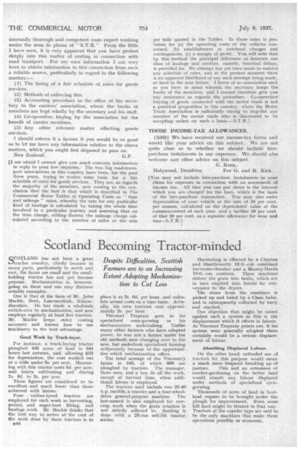Scotland Becoming Tractor-minded
Page 54

If you've noticed an error in this article please click here to report it so we can fix it.
Despite Difficulties, Scottish Farmers are to an Increasing Extent Adopting Mechanization to Cut Loss
SCOTIAND has not been a great tractor country, chiefly because in many parts, particularly to north and east, the farms are small and the smallholding tractor has not yet become popular. Mechanization is, however, going on there and one may discover notable examples.
One is that of the farm of Mr. John Mackie, Bent, Laurencekirk, Kincar. elineshire. He has made a wholesale switch-over to mechanization, and now employs regularly at least five tractors. Mr. Mackie keeps strict costing accounts and knows how to use machinery to the. best advantage.
Good Work by Track-layer.
For instance, a track-laying tractor ploughed 436 acres of land in 544 hours last autumn, and, allowing £52 for depreciation, the cost worked cut at a trifle under 5s. per acre. Harrowing with this tractor costs 5d. per acre, and heavy cultivating and discing
Hd. to 2s. per acre.
These figures are considered to be excellent and much lower than those achieved with horses.
Four. •. rubber-tyred tractors are employed for such work as harvesting, potato and sugar-beet lifting, and haulage work. Mr. Mackie thinks that the best way to arrive at the cost of the work done by these tractors is to B44
place it at 2s. 6c1. per hour, and calculate actual costs on a time basis. Actually, his own tractors cost approximately 2s. per hour.
Viscount Ti-aprain goes in for specialized corn-growing in his mechanization undertaking. Unlike many other farmers who have adopted power, he was not a farmer under the old methods, now changing over to the new, but undertook specialized farming deliberately because of the opportunities which mechanization offers.
The total acreage of the Viscount farms is 840, of which 660 are ploughed by tractors. The manager, three men, and a boy do all the work, except at harvest time, when additional labour is employed.
The tractors used include two 25-40 h.p. models, a crawler and a four-wheeldrive general-purpose machine. The last-named is also employed for rowcrop work when the grain rotation is not strictly adhered to. Seeding is done 'with a 2S-run self-lift tractor seeder.
Harvesting is effected by a Clayton and Shuttleworth 12-ft.-cut combined harvester-thresher and a Massey-Harris 10-ft.-Cut combine. These machines deliver the grain into tanks, which are in turn emptied into lorries for conveyance to the dryers.
The straw from the combines is picked up and baled by a Class baler, and, is subsequently collected by lorry and stacked,
One objection that might be raised against such a system as this is the displacement which it effects in labour. As Viscount Traprain points out, if his system were generally adopted there certainly would be a serious displacement of labour,
Absorbing Displaced Labour.
On the other hand, extended use of tractors for this purpose would mean a much More frequent breaking up of pasture. This and an extensionof market-gardening on the better land would absorb any labour displaced under methods of specialized corngrowing.
Thousands of acres of land in Scotland require to he brought under the plough for improvement. Even some hill land might be treated in that way. Tractors of the crawler type are said to be the only machines that make these operations possible or economic.




















































































